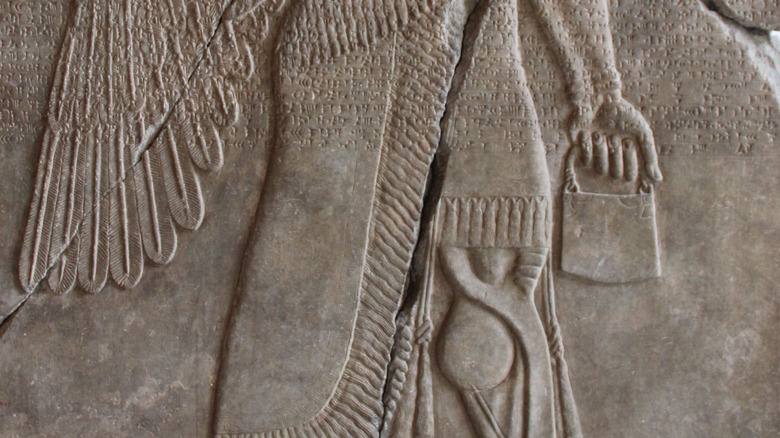The Unsolved Mystery Of 'Handbags' In Ancient Stone Carvings
By now, many of us likely have at least heard of "Ancient Astronaut Theory." Described in detail on sites like Interesting Engineering, it goes like this: a) ancient people build something or do something beyond the presumed knowledge or abilities of homo sapiens of their times (construct the Pyramids at Giza, maybe), even though no different to us in anatomy or cognition; b) modern pseudo-scientists stand in awe at the accomplishments of those "primitive" (a deplorable word) people, and in a presumption of utter, modern hubris, believe that there's no way those ancient people could have built or done X, Y, or Z; and then the conclusion, c) aliens.
Add to this a bit of hunt-and-peck confirmation bias (The Sphinx shows signs of water damage, per GeoExpro), architectural and artistic similarities across the globe (both Mesoamerican and Mesopotamian civilizations built pyramids), and a bit of historical revisionist fantasy fulfillment narratives (Atlantis really did exist, and its descendants by way of the old Flood and Noah's ark story spread their shared culture of pyramid building across the globe), and presto: crash course complete. To be fair, not all ancient astronaut theorists necessarily tie all these threads together, but the basic idea is: romanticize the past because, seriously, where are all the flying cars?
Sometimes, though, curious elements of ancient architecture and art do stand out and beg for explanation. Such is the case with the "handbags" seen on numerous stone reliefs across the globe.
Even ancient gods had fashion sense
When we say "handbags," we mean carvings depicting things that look like modern handbags: A semicircular handle on top connected to a rectangular base on the bottom. Not quite Coach or Kate Spade, but you get the idea. Humanoids in stone carvings are often depicted carrying them, and these handbag things are everywhere across the globe at various ancient sites across a wide range of time.
As Ancient Origins says, the handbags appear on the world's "oldest temple," Gobelki Tepe in Turkey, dating back to 11,000 BCE. They also appear in Olmec carvings (1200–400 BCE) in modern-day Mexico, in ancient Assyria (880-859 BCE) and Sumer (4100-1750 BCE), and are possibly a variation on the Egyptian ankh carried by deities such as Horus.
So how does this connect at all to ancient astronaut theory? Ancient carvings typically depict gods, which in and of itself isn't surprising; in the modern day, corporate logos, like god imagery, emblazon every good. Plus, gods were believed to have had magical powers. If we adopt the ancient astronaut perspective — namely, that stories of ancient "gods" were in fact mythologized narratives of aliens with high technology lording it over "primitive" humanity — then these carvings of gods with handbags must be carvings of aliens carrying submission-levying devices like Loki's Tesseract from the Avengers or something.
When a handbag is just a handbag
For those seeking an Occam's Razoresque solution to this mystery handbag thing, the answer is simple. They are what they appear to be: bags. Does anybody think that carrying devices — baskets, boxes, crates — are new inventions? Didn't people have to carry things since, like, always? That's just a literal interpretation. Even symbolically, doesn't it make sense that gods and rulers would be depicted as holding, or retaining, objects of either plenty (food, drink, wealth) or power?
So maybe this whole handbag mystery goes back to art. Representative art — art that depicts real-world things — is older than abstract art. We know this because of cave paintings of lions, mammoths, and the like, such as those discussed in Smithsonian Magazine. We haven't found a Neolithic Jackson Pollock (although to be fair, would we even notice?).
All art also retains an individual style. Love of style leads to abstract shapes and designs. Tattoos, for instance, are often ascribed mystical and ritualistic power when spoken of in the context of traditional cultures, as with the Maori, as Zealand Tattoo explains. But maybe ancient people, just like us, thought that some things looked cool. Maybe the whole handbag carving was a design statement as well as representative art.
As to why the handbags are everywhere: Clothes are also present in carvings everywhere, but no one marvels at that. Why the belief that ancient people were so dramatically different from us?
Alternative explanations can get a bit out there
There are other explanations for these ancient images of handbags. As stated on Ancient Origins, "In ancient cultures from Africa to India to China, the figure of a circle was associated symbolically with concepts of spirituality or non-materiality, while that of a square was often associated with concepts of the Earth and of materiality." And so, "the image is used to symbolize the (re)unification of the earth and sky, of the material and the non-material elements of existence." Medium, on the other hand, quotes non-mainstream historian Graham Hancock asking, "Could these containers (whether they are bags or buckets) be the symbols of office of an initiatic brotherhood — far traveled and deeply ancient, with roots reaching back into the remotest prehistory?"
International Business Times asks, "Could these bags represent seeds that were preserved onboard the ark in some sort of vault, maybe they were distributed across the World as we repopulated the Globe after the Great Flood?" Finally, Ancient Origins also relates the potrepreneur's version, "When used in Assyrian art it is said the purse holds magic dust. When depicted in Olmec art they postulate it contains herbs for getting high."
So what's more reasonable: Any of these explanations, or that the handbags on the stone reliefs are, well, handbags? Not as fun? Sure. More realistic? Quite a bit. After all, if future historians find tons of pictures of people carrying handbags, we can assume they won't believe the bags are inexplicable alien devices.



